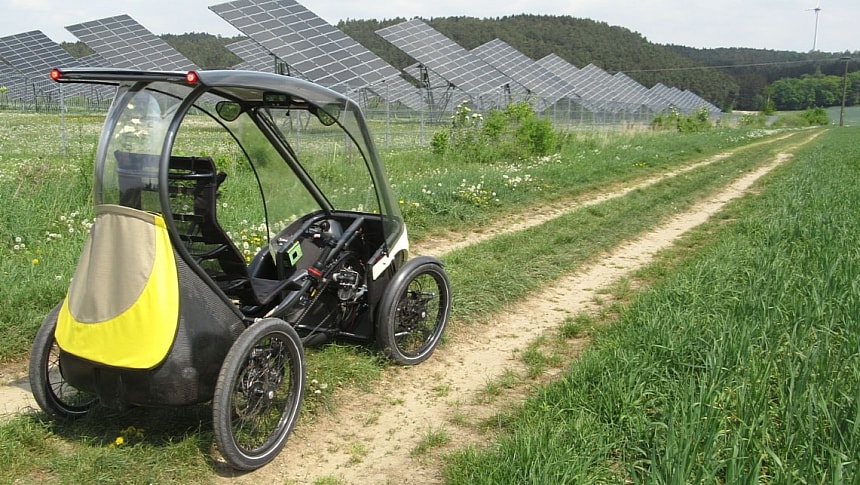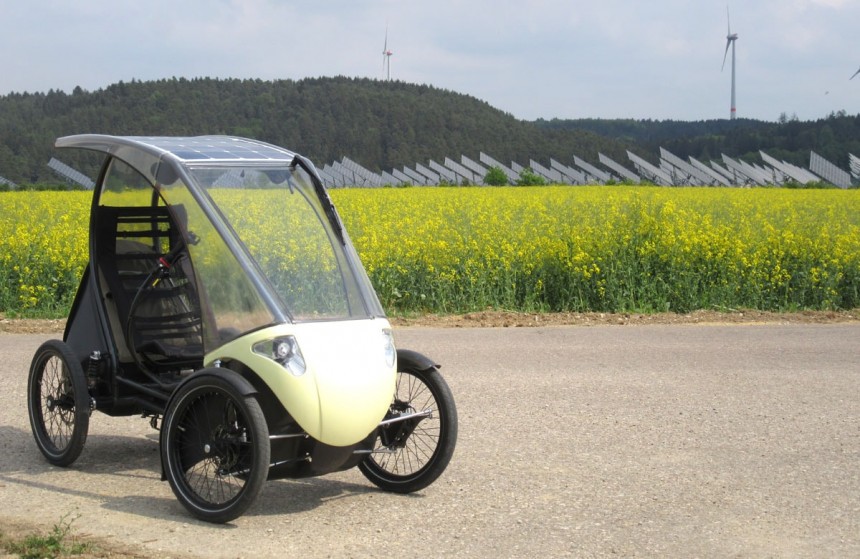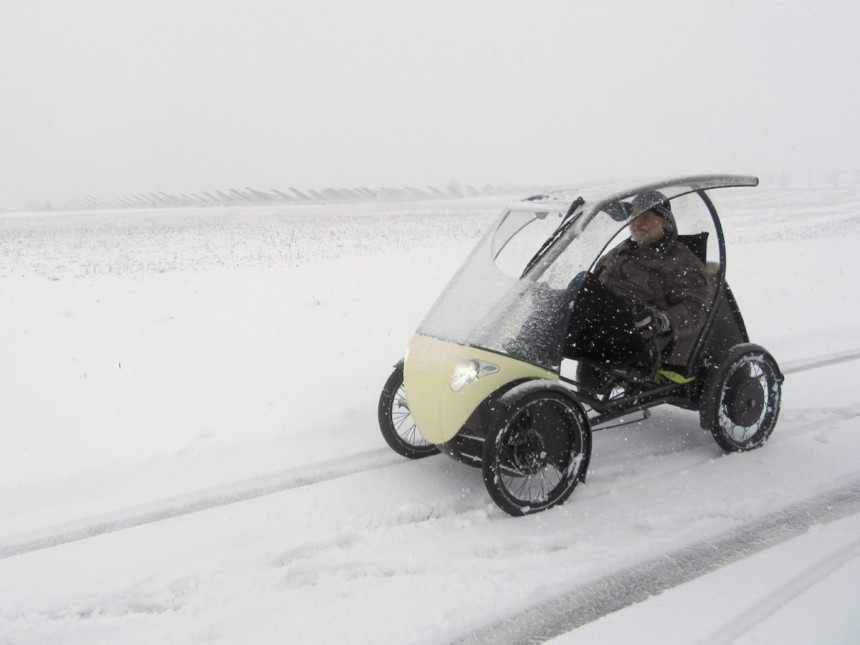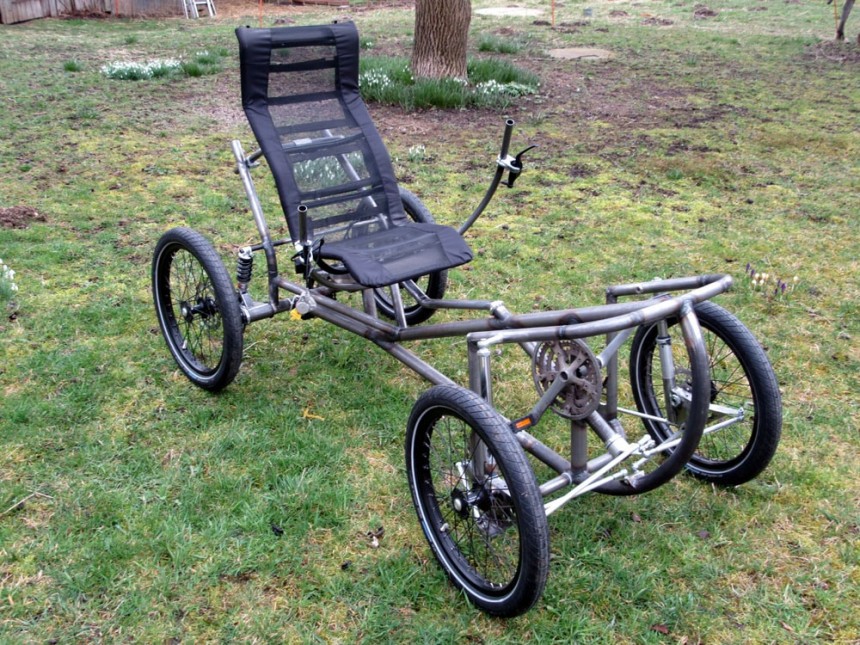A few years ago, the world was graced by a velomobile project that promised to be the urban mobility solution we've all been waiting for all these years, and then a couple of years later, it just vanished from the news. This is one possible story to Pedilio.
Folks, I don't expect you to have ever heard of Pedilio, except if you were in Europe a few years ago, and even then, the chances that you were in Germany are even smaller. Nonetheless, my search for mobility devices that are meant to change the way we do inner-city travel has led me to this project. Let's see what we missed.
Now, what made Pedilio so neat is that it wasn't just a velomobile with a semi-enclosed shell, but also the fact that this thing was also designed to be solar-powered. The very top of the body showcases a solar panel for transforming the sun's endless supply of energy into your own. By using a 100 W solar panel, this vehicle's range was extended by up to 30 km (19 mi) each day, under the right conditions, of course.
This brings us to range. Pedilio still advertises a maximum range of up to 100 km (62 mi), thanks to the presence of up to two batteries packing 16 Ah of total juice. Clearly, this is dependent on road conditions, and considering there are four wheels in constant contact with the ground, friction is bound to play a big factor in the maximum range.
All this energy had but one purpose, that of feeding power to the one and only motor this machine was equipped with—a tad strange if you ask me. I say "strange" because Pedilio strapped a measly 250 W motor to the rear left wheel of this four-wheel EV, and since there's just one motor present, we can grasp how the range I mentioned is possible.
Apparently, regenerative braking was also part of the mix, and believe it or not, the Pedilio could reach a top speed of up to 45 kph, placing it in Europe's L6e category of vehicles, so you wouldn't actually need a license to be out of on the streets.
With some of the green energy magic behind this project, let's move on to the less important traits. The first is the fact that this EV was designed to help riders get out there and move around town without being exposed to the elements. To do that, Pedilio created a shell from nothing other than carbon fiber and PET, so it was clearly light and strong, well, enough to the point of handling rain, snow, and shine. Since the side doors were missing, ventilation was clearly not an issue and even the manufacturer bragged about the lack of heat retention.
Plenty of features were in place for the rider's comfort, all designed to keep the rider in the seat for as long as possible. Aside from the shell, comfort was improved by the recumbent bike-style seating found inside; a rider would be leaning back and pedaling with feet out in front.
As for steering, it was all controlled via two levers on each side of the operator, each equipped with levers to activate this EV's brakes for slowing down and controlling. I like to compare the setup to a sort of go-kart racing rig, clearly dumbed down for your safety.
The final piece of the comfort puzzle is found when we take a closer look at the Pedilio's suspension. What I found rather neat about this vehicle is the presence of a completely independent suspension, the sort of setup you want if you're out there riding the Pedilio on the terrain the manufacturer showcases.
The question is where this project went. Well, we don't know, and neither do sources say anything. All we know is that it was up and running for about three years, with some units delivered to customers, and then simply vanished. Nor do we have any idea how much these babies were selling for.
Personally, I like to think that Pedilio was onto something here, and with a few improvements, this EV could have very well stood a chance of being a mobility choice for countless cities across the world. One change I would make is to add another motor to the right rear wheel, raising control but lowering range; that just calls for another battery pack.
This brings me to my last and final point regarding the Pedilio. It resurfaced this year, 2024, at Spezi 2024, and the manufacturer has even announced that this EV will be present at the same event in 2025. Oh, and by the looks of things, yes, it's a tad different, so the crew has clearly been active under the radar. Head down to Germany and see it for yourself.
Now, what made Pedilio so neat is that it wasn't just a velomobile with a semi-enclosed shell, but also the fact that this thing was also designed to be solar-powered. The very top of the body showcases a solar panel for transforming the sun's endless supply of energy into your own. By using a 100 W solar panel, this vehicle's range was extended by up to 30 km (19 mi) each day, under the right conditions, of course.
All this energy had but one purpose, that of feeding power to the one and only motor this machine was equipped with—a tad strange if you ask me. I say "strange" because Pedilio strapped a measly 250 W motor to the rear left wheel of this four-wheel EV, and since there's just one motor present, we can grasp how the range I mentioned is possible.
Apparently, regenerative braking was also part of the mix, and believe it or not, the Pedilio could reach a top speed of up to 45 kph, placing it in Europe's L6e category of vehicles, so you wouldn't actually need a license to be out of on the streets.
Plenty of features were in place for the rider's comfort, all designed to keep the rider in the seat for as long as possible. Aside from the shell, comfort was improved by the recumbent bike-style seating found inside; a rider would be leaning back and pedaling with feet out in front.
As for steering, it was all controlled via two levers on each side of the operator, each equipped with levers to activate this EV's brakes for slowing down and controlling. I like to compare the setup to a sort of go-kart racing rig, clearly dumbed down for your safety.
The question is where this project went. Well, we don't know, and neither do sources say anything. All we know is that it was up and running for about three years, with some units delivered to customers, and then simply vanished. Nor do we have any idea how much these babies were selling for.
Personally, I like to think that Pedilio was onto something here, and with a few improvements, this EV could have very well stood a chance of being a mobility choice for countless cities across the world. One change I would make is to add another motor to the right rear wheel, raising control but lowering range; that just calls for another battery pack.
This brings me to my last and final point regarding the Pedilio. It resurfaced this year, 2024, at Spezi 2024, and the manufacturer has even announced that this EV will be present at the same event in 2025. Oh, and by the looks of things, yes, it's a tad different, so the crew has clearly been active under the radar. Head down to Germany and see it for yourself.















